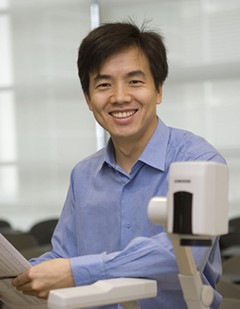Subject:Light-Matter Interactions in Polar Semiconductor Nanomaterials
Speaker:Prof. Qihua Xiong
Emcee:Prof. Jianpin Yin
Time:10:30am, 24th Jan, 2018
Place:Science Building A510
Qihua Xiong received his B.S. degree in physics from W uhan University in 1997, and then finished three years graduate studies at the Shanghai Institute of Applied Physics, Chinese Academy of Sciences. He went to the United States in 2000 and received Ph.D. degree under the supervision of Prof. Peter C. Eklund from The Pennsylvania State University in 2006. After three years postdoctoral experience in Prof. Charles M. Lieber’s group at Harvard University, he joined Nanyang Technological University as an assistant professor in 2009 and promoted to Nanyang Associate Professor in 2014. He was promoted to full Professor in 2016 recently. He is a Fellow of Singapore National Research Foundation awarded in 2009 and the inaugural NRF Investigatorship Award by Singapore National Research Foundation in 2014. He is the recipient of IPS Nanotechnology Physics Award (2015) and Nanyang Award for Research Excellence of NTU (2014). Prof. Xiong’s research focuses on light-matter interactions of emergent quantum matter by optical spectroscopy approaches. He recently ventured into the field of 2D layered materials and laser cooling of solids.

Abstract:
The interaction of light with matter gives rises to a wide range of linear and nonlinear phenomena that we are familiar with, such as absorption, scattering, spontaneous or stimulated emission, and second harmonic generation. In insulators or semiconductors, the electromagnetic field of light polarizes the matter leading to the formation of elemental excitations such as excitons and exciton polaritons, due to long-range dipolar force as well as additional coupling to the optical fields. In this talk, I will first introduce the background of exciton, exciton polaritons and the electron/exciton-longitudinal optical (LO) phonon interactions in semiconductors. I will then present the resolved-sideband Raman cooling of LO phonons in semiconductors using ZnTe nanoribbon as a model system. The essential picture follows a similar physical picture of cavity optomechanics, whereby the LO phonon sidebands can be tuned to be in resonant with excitonic modes. Cooling or amplification of optical phonons can be realized by changing the detuning of pump laser. Next, I will introduce our latest work on room temperature exciton-polariton lasing in all-inorganic perovskite CsPbCl3 crystals embedded in optical microcavities. Those crystals have exceptionally large exciton binding energy, strong oscillator strength and can be grown by facile epitaxy-free techniques. Polariton lasing is unambiguously evidenced by a superlinear power dependence, macroscopic ground state occupation, blueshift of ground state emission, and the build-up of long-range spatial coherence. Our work suggests considerable promise of lead halide perovskites towards large-area, low-cost, high performance room temperature polariton devices and coherent light sources extending from the ultraviolet to near infrared range. The talk will be concluded by some progress of coupling atomic-thin layered semiconductors into microcavities.
References:
1.R. Su, et al., “Room temperature polariton lasing in all-inorganic perovskites”, Nano Lett.17, 3982-3988 (2017)
2.Q. Zhang, et al., “High quality whispering-gallery-mode lasing from cesium lead halide perovskite nanoplatelets”, Adv. Funct. Mater.26, 6238-6245 (2016)
3.J. Zhang, et al., “Resolved-sideband Raman Cooling of an Optical Phonon in Semiconductor Materials”, Nature Photonics10, 600-605 (2016)
4.S.T. Ha, et al., “Laser cooling of organic-inorganic lead halide perovskites”, Nature Photonics10, 115–121 (2016)

